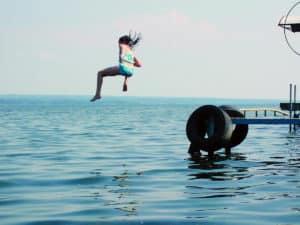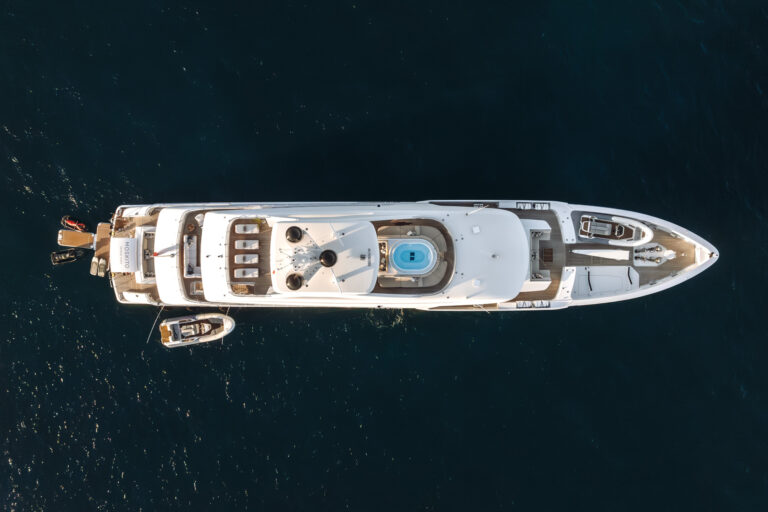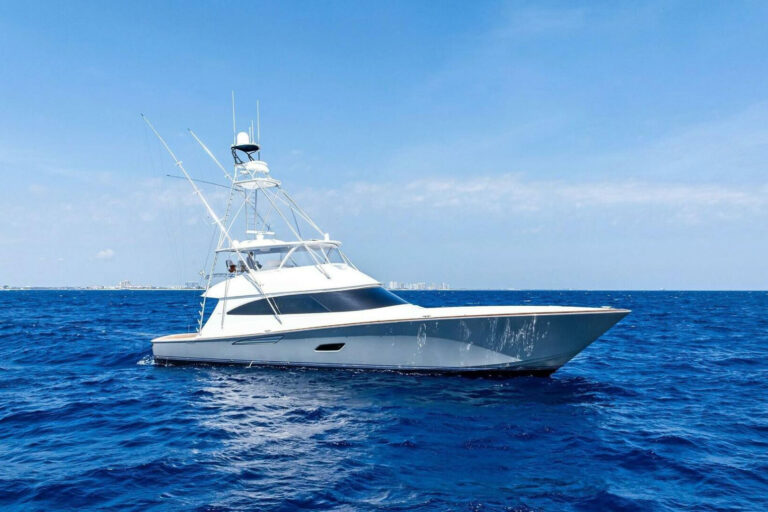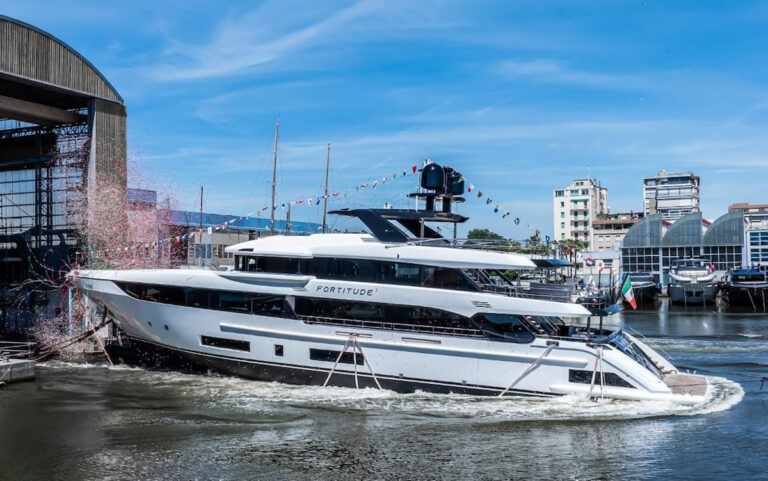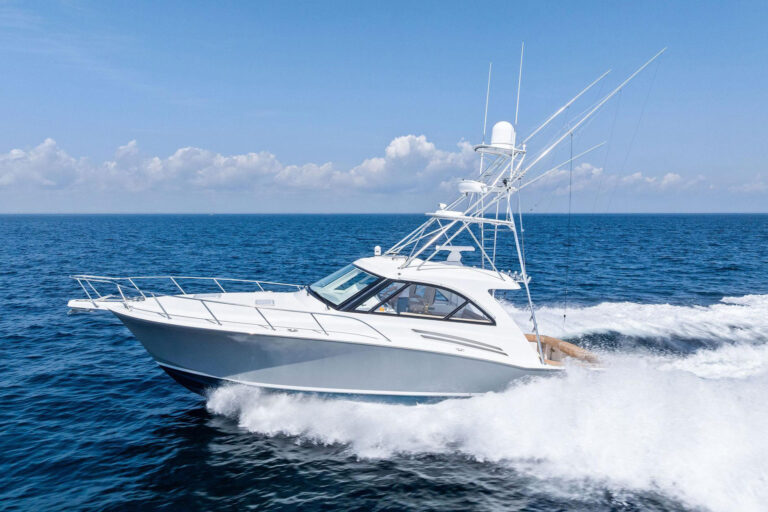A rigged bet led Bill and Kristen Golden to buy Nantucket Lightship WLV 612 via eBay. The conspiracy went like this. Bill was keen to spend time living on a boat, but Kristen was not. To get his wish, Bill had one of his friends, Steve Elkecton, make a bet with Kristen that if Steve agreed to eat sushi for the first time, Kristen would agree to live on a boat for a year.
Steve called one day and left a voice message for the Goldens, saying, “Your ship has come in! Kristen had lost the bet.”
“Steve had seen a retired Nantucket Lightship up for auction on eBay,” Bill said, “and thought we would be interested”. When the Goldens saw the ship for the first time, only three to four days remained in the auction. “We soon realized that the other bidders were simply planning to break the boat up and sell it for scrap (especially with a wheelhouse made of brass). The history of this lightship intrigued the Goldens, and they decided to preserve a piece of tradition by finding an alternative use for her. They planned to retain the exterior appearance of the ship and modify the interior to give it a new life and then offer her for charter in Nantucket and Boston.
Bill Golden, an environmental lawyer who was involved in the setting up of the EPA and the cleaning up of Boston Harbor, devised a unique bidding plan, which he refused to disclose in case he wants to use it again. The Goldens jumped into the bidding with 20 minutes remaining and won with a last-second bid of $126,100. At that point it was the largest item ever purchased from eBay.
Lightships have a long and colorful history. The U.S. Coast Guard used them as navigational guardians along coasts of the United States for more than a century. (Lightships were anchored there and at other critical areas to alert ships they were nearing treacherous waters.) Serving on one of the Coast Guard’s bright red lightships might have been considered hazardous duty for the crews; certainly it was not very sociable. Imagine being anchored for three or more weeks at a time, buffeted by 70-80-knot winds and mammoth waves.
Lightship WLV 612’s final service was off the coast of Nantucket. In the early days of the United States, mostly whalers and fishermen inhabited Nantucket, and their lives depended on the lightship’s guidance.
Anchored 20 to 50 miles south and east of Nantucket Island, from 1854 through 1983, the lightships have a storied history. Seen looming out of the fog or on the horizon, they were often the first glimpse travelers had of their arrival in the United States. Because of the dangerous shoals surrounding Nantucket, the ships had to remain on station regardless of the weather. Their horns bellowed into the fog that frequently engulfs this area, which made conversation among the crew almost impossible. Massive lights warned ships of approaching shallows, and radio signals served as navigation beacons for the transatlantic ships. One of these radio beacons guided the S.S. Olympic, sistership to the Titanic, right up to and through one of the lightships in 1934, killing seven of the eleven crew on board. Watches for the 12 crew were tedious, but necessary to make sure that the lights, horns and radio beacons operated 24 hours a day, seven days a week.
The Goldens’ Nantucket lightship was built in Curtis Bay, Maryland, in 1950 and first went to San Francisco, where it served for 18 years. The Coast Guard next dispatched it east to Portland, Maine, and finally Nantucket, where it persevered until it became in 1983 the last lightship station to be replaced by a buoy. Following its retirement and several failed attempts at restoration, WLV 612 lay forgotten and in disrepair.
Resurrection of the lightship became a true labor of love for the Goldens-it had to be to transform this Coast Guard working ship into an elegant floating residence suitable for upscale Nantucket. True, the ship’s engines were inoperable; her tanks held 14,000 gallons of contaminated diesel, and asbestos covered every surface that required fireproofing. All this needed to be removed, but the Goldens rose above the enormity of the project, simply seeing the potential for the ship to provide 4,000 square feet of living space and 2,000 square feet of deck area. Also, the historical value helped spur them onward-this ship and many others like it are an icon of United States’ maritime history.
Even prior to acquiring the lightship, the Goldens had developed a plan to resurrect her and refit her with a luxurious interior. Kristen Golden left design school and began to design the interior. She also acted as the general contractor for the project. To continue the theme of preserving U.S. maritime history, they decided to have the restoration work done by shipwrights and artisans in New Bedford, Massachusetts, close to the ship’s last station.
Workmen gutted WLV 612, right down to the steel hull. They emptied the fuel; removed the engines, transmissions and generators. They kept a few artifacts, such as a game table and one of the berths used by the crew, which they would install in the new accommodations. There is the occasional hatch or bulkhead, but otherwise the interior reminds you more of a luxury hotel or home, than a ship capable of surviving hurricane winds. Only the exterior would remind someone that this was once a working ship.
As the workers prepared the interior for what was to come, Kristen spent her time thinking about what that should be. “For the first three months, I just spent time walking the boat, trying to determine what might be the proper layout for the interior and to decide on what materials to use, Kristen commented. “We wanted to make this an American ship as much as possible. The Goldens decided to use American products and species of wood wherever possible, hence the birch soles, cherry walls and furnishings and granite counter tops in the kitchen and heads.
“We wanted to give the ship a rich nautical tradition and warm hospitality”, Kristen said. Each of the ship’s six guest cabins is equipped with a private head. The master cabin has a large four-post bed made of mahogany. The beds are large and comfortable, and in particular, one of the lower cabins is great for children, with one queen-size bed and two double bunks. The ship has great accommodations for three to four couples and their children, which have been the typical charters.
In addition, there are two common areas. One is an elegant combined dining area and saloon, each of which can easily accommodate 12 guests. Both give the feel of sitting and being entertained in a comfortable club, surrounded by marine artwork and wood paneling. The dining area is suitable for formal dining, and several seating areas help fill this full-beam section of the ship.
The second is the recreation room on the lower deck, which has leather club chairs, a full entertainment area, including a large plasma screen television, and perhaps the most interesting piece, a card table. The card table actually came from the wardroom of the ship and when opened, it still had the playing cards and poker chips that whiled away the hours when the crew were on station.
But rest assured, the beauty of this ship is more than skin deep. As part of the reconstruction process, the Goldens replaced all the interior wiring and piping. A new Caterpillar engine was installed, along with two new generators. There are also eight zones in the heating and air conditioning system so guests can alter the environment to their personal preference.
When you head up to the bridge, the huge wheel and two eight balls, one mounted each side of helm, may trouble you. The Lionel Corporation made them in 1942, so perhaps the Coast Guard scavenged them from another ship. To allay any fears caused by the antiques at the helm, the lightship is equipped with the latest navigation and mechanical equipment, although it is hidden in a cabinet so the bridge retains an authentic look and feel.
If you charter the lightship during its summer stay in Nantucket, you may feel as though you are sitting on station off the coast. A look around, though, brings you back to the reality of the moment-umbrellas for shade, wooden decks and deck chairs and other luxuries the crews never had. The ship still retains its two masts and beacons, as well as the fog horns, but you aren’t required to stand a four-hour watch or have the silence broken every 30 seconds by the sounding of the fog horn. Once you enter the ship you are surrounded by real Nantucket lifestyle, all elegance and comfort, a fitting retirement for this piece of American maritime history.
For charter information contact: Nantucket Lightship; (617) 821-6771; www.nantucketlightship.com May-September: On dock or at anchor in Nantucket ($14,000-$21,000 per week). October-March: Rowes Wharf, Boston.
Craig Davis has traveled around the world covering yachting as a photojournalist and writer.


